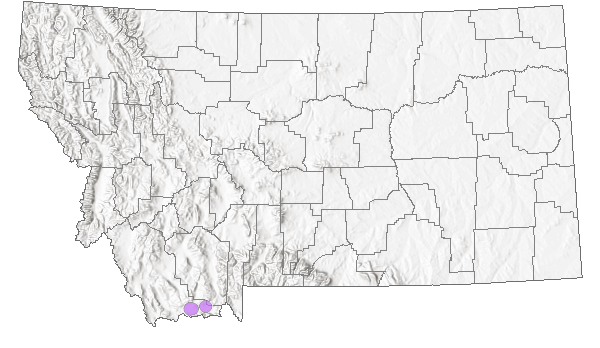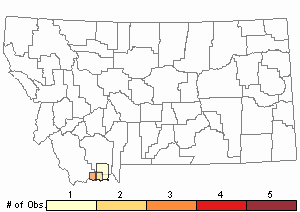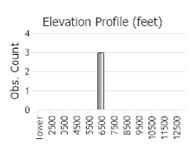View in other NatureServe Network Field Guides
NatureServe
Montana
Utah
Wyoming
Idaho
Wisconsin
British Columbia
South Carolina
Yukon
California
New York
Sand Wildrye - Elymus flavescens
Other Names:
Yellow Wildrye,
Leymus flavescens
State Rank Reason (see State Rank above)
Sand wildrye occurs at the edge of its range in Montana, where it is known from one small population in the Centennial Valley sandhills. It requires early successional sandy habitats, which are localized in sand deposition areas of the dunes. This habitat is at risk from dune succession and stabilization that can result from suppression of natural disturbance regimes such as fire and grazing.
General Description
Stems solitary to few-bunched, 60–100 cm. Leaves: blades 3–6 mm wide, inrolled. Inflorescence 10–22 cm long, the rachis continuous and erect. Spikelets mostly 2 per node, 10–20 mm long; glumes narrow, faintly 3-nerved, tapering to an awn-tip. Lemmas mostly 2 to 5 per spikelet, copiously long-hairy, awnless or awn-tipped (Lavin in
Lesica et al. 2012. Manual of Montana Vascular Plants. BRIT Press. Fort Worth, TX).
Phenology
Fruiting occurs in July-August.
Diagnostic Characteristics
The long-hairy, almost feathery appearance of the spikelets separates this species from other members of Elymus and Agropyron (sensu lato). Elymus innovatus is also rhizomatous with hairy lemmas, but the hairs are not nearly as long, and the spikes are usually less than 10 cm in length.
Species Range
Montana Range
Range Descriptions

 Native
Native
Range Comments
WA and OR, east to southern ID and southwest MT. Peripheral.
Observations in Montana Natural Heritage Program Database
Number of Observations: 6
(Click on the following maps and charts to see full sized version)
Map Help and Descriptions
Relative Density

Recency



 (Observations spanning multiple months or years are excluded from time charts)
(Observations spanning multiple months or years are excluded from time charts)
Habitat
Sand wildrye occurs in sandy soils throughout its range. In Montana it is found in sand-deposition areas of sand dunes, where it is associated with Stipa comata and Agropyron caninum. The species has also been found on sandy roadsides.
Ecological Systems Associated with this Species
Ecology
Historically, the early successional, open-sand habitat required by this species was maintained by a fire cycle of 20-30 years and ungulate grazing. Pocket gopher (Thomomys talpoides) activity also appears to be an important force in initiating blowouts and maintaining early seral vegetation (Lesica and Cooper 1998).
Management
Plant succession in open sand areas leads to a reduction in the open-sand habitat this plant requires (Lesica and Cooper 1998). Its early successional habitat could likely be maintained with restoration of the historic fire regime and moderate grazing, at least in years following burns. Compaction and severe disturbance by off-road vehicle use may also damage its habitat.
Stewardship Responsibility
Threats or Limiting Factors
STATE THREAT SCORE REASON
Reported threats to Montana's populations of Sand Wildrye concern management actions that lead to habitat loss (MTNHP Threat Assessment 2021). Sand dune substrates that are occasionally impacted by fire and wind erosion are critical to population survival. Fire suppression and vegetation management intended to stabilize sand dunes reduces available area for Sand Wildrye to colonize. Information on the scope, severity, and timing of this threat is needed.
References
- Literature Cited AboveLegend:
 View Online Publication
View Online Publication Lesica, P., M.T. Lavin, and P.F. Stickney. 2012. Manual of Montana Vascular Plants. Fort Worth, TX: BRIT Press. viii + 771 p.
Lesica, P., M.T. Lavin, and P.F. Stickney. 2012. Manual of Montana Vascular Plants. Fort Worth, TX: BRIT Press. viii + 771 p. MTNHP Threat Assessment. 2021. State Threat Score Assignment and Assessment of Reported Threats from 2006 to 2021 for State-listed Vascular Plants. Botany Program, Montana Natural Heritage Program, Helena, Montana.
MTNHP Threat Assessment. 2021. State Threat Score Assignment and Assessment of Reported Threats from 2006 to 2021 for State-listed Vascular Plants. Botany Program, Montana Natural Heritage Program, Helena, Montana.
- Additional ReferencesLegend:
 View Online Publication
View Online Publication
Do you know of a citation we're missing? Culver, D.R. 1994. Floristic analysis of the Centennial Region, Montana. M.Sc. Thesis. Montana State University, Bozeman. 199 pp.
Culver, D.R. 1994. Floristic analysis of the Centennial Region, Montana. M.Sc. Thesis. Montana State University, Bozeman. 199 pp. Lesica, P. & S. V. Cooper. 1998. Succession and disturbance in sandhills vegetation: constructing models for managing biological diversity. Conservation Biology 13:293-302.
Lesica, P. & S. V. Cooper. 1998. Succession and disturbance in sandhills vegetation: constructing models for managing biological diversity. Conservation Biology 13:293-302. Lesica, P., M.T. Lavin, and P.F. Stickney. 2022. Manual of Montana Vascular Plants, Second Edition. Fort Worth, TX: BRIT Press. viii + 779 p.
Lesica, P., M.T. Lavin, and P.F. Stickney. 2022. Manual of Montana Vascular Plants, Second Edition. Fort Worth, TX: BRIT Press. viii + 779 p.
- Web Search Engines for Articles on "Sand Wildrye"





